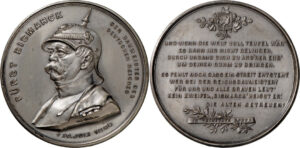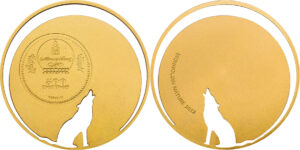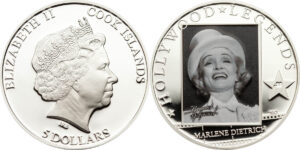
Who doesn’t know this image: in her legendary role as cabaret singer Lola Lola, Marlene Dietrich sits on a barrel wearing a top hat, her leg seductively bended, displaying a vacant, tempting gaze. A thought experiment: imagine this picture on the reverse of a medal – and then imagine Paul von Hindenburg on the obverse, who was President of the German Reich in 1930 when “The Blue Angel” was filmed. Hindenburg with his hair accurately combed back, the determined gaze of an iron field marshal general and the handlebar moustache. Do you have to smile imagining this unequal couple featured together on an issue? In fact, nobody would have even thought of it at the time. But why not? And why are things different now? To find the answer, let’s go back in time a little bit more, to the German Empire.

Medals in the German Empire: Germany, Germany Above All
1871 marked the end of the centuries-long era of small and smaller Imperial Estates, principalities which one had to look for with a magnifying glass on the map of central Europe. It was also the end of ever-present custom issues, export licences and other obstacles in the way of the Germans to a modern nation, a nation of patriots. Such idealism was needed in order to welt together the newly united empire also on the inside. But what should be the glue of the society? For one thing the common language. Goethe, Schiller and their colleagues were perfectly suited as draught horses in front of the carriage of a newly emerging national identity, their works were compulsory readings at school. However, compulsory education was not a thing before it was laid down in the Weimar Constitution, until then, the army served as “school for the nation”. During their two years of compulsory military service, young men internalized the values of the German Empire: a strong belief in authorities, love for the ruler and the motherland, the legendary German blind obedience and the military code of honour. The men took all these seeds from their knapsacks into their civilian life and made militarism flourish in all shapes and colours.
At least among members of the bourgeoisie and the upper classes of society, there was a broad consensus about what was socially acceptable and what was not. Although enjoying the work of actors and cabaret singers was a popular leisure activity, nobody would have thought of awarding them with a public honour.
So what can we see on the medals of that time? Because it is true that medals existed, and educated citizens collected them diligently. At the very least, commemorative issues served the purpose of expressing the Empire’s convictions with an aesthetically pleasing object. Just like one put a bust of Goethe on one’s desk, people displayed their medals in a showcase: a medal commemorating the death of Bismarck in 1898, for example. Or how about Emperor William II wearing his dress uniform and the completion of the Kyffhäuser Monument, which was erected at the suggestion of the War Veterans Federation and completed in 1896. They simply wanted to demonstrate to the “Sozen” (“pinkos”) that Germany was loyal to its monarch in a Wilhelminian, monumental manner.

These pieces were produced by the Stuttgart company Mayer & Wilhelm, which issued several series of famous men. Of course, only men could be famous at that time. By the way, in recent years, the company Mayer & Wilhelm has comprehensively documented its extensive medal production created over the course of 150 years in several catalogues. Popular motifs were great inventors such as Zeppelin, composers like Meyerbeer and most of all: noblemen, politicians and military officers – and most of them checked all of these boxes. Graf von Moltke, William II King of Württemberg, dukes and princes of Saxony and, of course: Bismarck and the emperor.
Lights Off, Sound Up! The Motion Picture Enters the Stage
The First World War put an end to German monarchy. At the same time, a completely new invention experienced a meteoric rise. Since 1896, the two Lumière brothers from France had been showing short films at fairs and festivals with their cinematograph, inspiring a wide audience. Less than fifteen years later, an international film industry had established itself and created another invention for the sake of marketing: the movie star. A movie star’s asset was the illustrious aura surrounding him. Behind the scenes he was chained to his film studio by means of a gagging contract of several years. After all, the studio invested a lot of money into building this star in the sky of the movie industry to be able to bask in his fame afterwards. The system worked until the 1950s and actors moved to the centre of society. Only after being rejected by art experts, movies were accepted as an independent art genre. In a film-loving country such as France, the genre even was bestowed the title of “Seventh Art”. However, there is one thing that did not happen in all these decades: no country, no private mint would have honoured someone like Cary Grant or Hans Albers, Marilyn Monroe or Marlene Dietrich by immortalising them in gold or silver.

From Forming a National Identity to Becoming Investment Products
The great turning point came about for economic reasons, that is the silver boom in the mid-1960s, when Germany’s working people wanted to invest their money in a crisis-proof manner. At this moment, banks and mints saw an opportunity. Wouldn’t it be a great idea to produce coins in order to meet the high demand for silver issues? This was the time of birth of the “collectors’ coin”. From then on, in addition to medals (issues without face value), there were issues called coins – but of course nobody would use them to pay in a shop because the value of the precious metal is much higher than the face value of the coin. The consequence: such coins became goods on the market, following the principle of supply and demand. Collectors’ coins were intended to be successful products. Since the end of the silver boom, investors – now referred to as collectors – have no longer simply bought anything that was on offer, instead, they have followed their taste. And mints have been eager to find out what this taste is and to meet it.
Although official coins of state mints might still represent the country’s interests in an illustrious way, private mints adapted to the prevailing taste. Today, Latin and Greek are no longer part of the standard knowledge of academics, and instead of the Brockhaus encyclopaedia on a shelf made of solid oak wood, the Wikipedia app on your smartphone provides you with the current stage of knowledge right from your pocket. German coin collectors do not choose between Merkel, Steinmeier and the German General Klein, they prefer the “Climate zones of the Earth” series or the howling wolf by the Liechtenstein company CIT Coin Invest AG. Welcome in the middle of society! And by now, products dedicated to the dream factory Hollywood also have their place here.

Stars on Coins
Keep in mind that we are talking about commemorative issues, not about official circulation money! In the German Empire, the obverse of a medal featured Bismarck while the reverse complemented his portrait with rustic oak leaves and pithy sayings such as “We Germans only fear God, nothing else in the world”. Nowadays, a coin’s reverse displays the mint’s abilities, while coins whose obverse featuring Queen Elizabeth is up are automatically turned by the observer as that side of the coin is nothing but a necessary embellishment. From animals to artworks and actors, everything that collectors love is possible.
For many countries, the 100 year anniversary of the movie theatre was an ideal occasion to commemorate masterful directors, diva-like actresses and their testosterone buffed colleagues in the mid-1990s. France, for instance, issued an extensive series between 1994 and 1996, and Gibraltar did the same. In 2012, the aforementioned company CIT Coin Invest AG dedicated a series to “Hollywood Legends” elaborately incorporating photographs into coins. Marlene Dietrich laughs at us on one of them, however, she looks a bit more chastely than in “The Blue Angel”. And so the Queen displayed on the other side of this issue minted for Cook Islands does not mind about it. When the Queen took office, something like that would have been – you know, unimaginable.
Occasionally, film and theatre actors were honoured: for example Ishihara Yujiro by Japan in 2006, Lucia Sturdza-Bulandra on a Romanian commemorative coin in 2013, and Ukrainian artist Maria Zankovetska in 2004 by her home country. However, these are exceptions.
Today, morality and a certain conviction of the government are no longer the reason preventing celebrities of the Seventh Art from being featured more often on medals. The phenomenon might simply have to do with the (assumed) demand of collectors.

Stars Disappear Behind Their Roles
Let’s think about the big movie stars: Humphrey Bogart and Audrey Hepburn became one with their role types, the cool hat and trench coat wearer, the neat, girly woman in a little black dress. These actors seemed as great and distinguished in everyday life as their roles did in the motion pictures. Today, however, they disappear behind their roles. Although it’s true that cinematic motifs are extremely popular on commemorative coins, have a look at the offer: Star Trek, Star Wars, Avengers, Justice League, Harry Potter … We see characters, not actors. Even when “western buddies” Bud Spencer and Terence Hill are celebrated, they are presented as film characters, not as the human beings Carlo Pedersoli and Mario Girotti. Nobody wants to see them without a cowboy hat and a gun.
Oh, and please note: apparently, fans of science fiction and fantasy works are a particularly interesting target group. Collectors’ coins fit in perfectly with a wide range of collectors’ gadgets like Star Wars helmets as key chains and the image of Doctor Who on coffee mugs. Until now, no coin series has been issued dedicated to German thriller and police television series. And yet it seems like Germans spend the majority of their free time watching such series. Are these people the wrong age group? What are young people doing?
Are YouTube & Co. the Future?
Let’s venture a glance into the future. Today, the world is turning faster than it did a generation ago. Decades passed between actors being socially accepted and their first appearance on coins. However, actors are no longer the idols of today’s youth. Today, stars are performing – on YouTube. Just like it was the case with the Beatles, teenagers go crazy when successful YouTubers like Mike Singer sign autographs in the real world. Will we see him on medals once his fans are of collecting age? Or is this a short-lived phenomenon and (almost) everything will remain as it is? Merkel, Steinmeier, General Klein …? Peppered with animals, sports, nature and tv series as popular motifs, all the things that one hundred years ago would have been – exactly: unimaginable.
Falls Sie den Text auf Deutsch lesen möchten: Der Artikel erschien ursprünglich im MünzenMarkt 29, der als Download auf unserer Seite verfügbar ist.
Read more about the “Hollywood Legends” Marlene Dietrich, Anita Ekberg and Robert Mitchum in this article, and here about Brigitte Bardot, Claudia Cardinale and Gregory Peck.
In 2017, France commemorated famous actor Jean Gabin in its 7th Arts Series.




